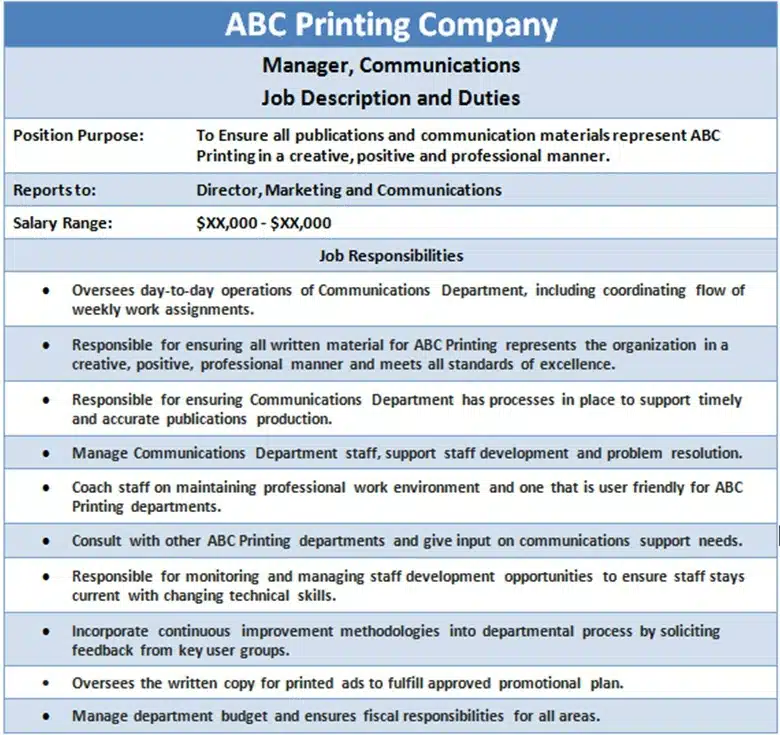Job Description Template
Estimated reading time: 5 minutes
Have you ever worked a job and didn’t really understand what it was you were expected to do? If so you are not alone. Many employees go to work every day without a job description.
Successful organizations put systems in place to help manage employees. The job description is part of that system.
Why Are Job Descriptions Important?
Employees need to know what is expected of them and who to go to with questions or concerns.
Job descriptions articulate reporting relationships, daily tasks, job responsibilities, and help guide employee performance.
Employees typically perform to the expected level – when they have a clear understanding of those expectations.
A detailed job description helps to articulate that expectation.
The job description is a tool managers use to set performance expectations and a gauge for measuring and managing that performance.
Job Descriptions Support Business Strategy
Job descriptions should reflect organizational goals and long-term strategy.
A strategic plan is translated into organizational goals. Organizational goals dictate departmental goals within the organization.
Once departmental goals are established, it is important to tie employee goals and job descriptions to those goals.
This effort to connect the dots helps employees see how what they do every day contributes to strategy and organizational goal attainment.

Job descriptions should be updated annually and used as part of the performance appraisal process.
This working tool should also articulate individual goals that support departmental goals.
Things to include in a job description:
- Job Title
- Reporting relationship
- Salary range
- Position Overview
- Job Responsibilities
Job Description Template

Making Job Descriptions Relevant
Managers need to constantly review job descriptions to keep them relevant to the employee’s role.
Take the following steps to ensure that employees spend their time doing those things that help the organization fulfill its mission.
1. Update job descriptions at least annually.
Job descriptions must stay current to ensure optimal performance.
To do this, review and update job descriptions at least annually. Use your annual planning meeting to set a date on the calendar to review job descriptions.
Initiate a conversation between the manager and the employee about job responsibilities and compare them to changing organizational strategies.
You may quickly learn that what was important a year ago may no longer be critical for achieving the mission today.
For instance, a year ago, sanitation procedures and employee safety were probably at the forefront of all job tasks. Now that the pandemic has slowed, priorities may have shifted back to your core business.
Employees are relieved when outdated responsibilities are removed, particularly when new ones are added to their job descriptions.
2. Observe what employees do every day.
It’s the manager’s responsibility to know what employees do every day.
And, to make sure that what they’re spending their time on truly reflects what is written in their job description.
I’m always amazed when I ask managers what their employees do every day, only to hear their response, “I don’t really know.” This response is often out of frustration.
A good starting point to rectify this situation is to simply ask employees to list everything they do.
I ask, “can you please provide me with a list of all of the projects you are working on, tasks you perform every day, and the approximate amount of time you spend on each.”
This exercise is a great way to get the employees thinking about what they do every day and will often shed some light on those things that rob employees of valuable work time.
3. Incorporate employee goals into their job description.
A strategy to achieve a mission should be what steers every organization. The strategy is implemented with organizational and departmental goals.
Departmental goals are divided among employees to share the responsibilities and to incorporate those responsibilities into daily job tasks.
For instance, let’s say you run a local dry cleaning business. You have a goal to improve customer satisfaction scores. Add this goal to employee job descriptions so that they understand their role in providing a great customer experience.
Taking these steps can ensure that employees are spending their time doing those things that contribute to fulfilling the organization’s mission.
3 Mistakes managers make with job descriptions
1. Not updating job descriptions regularly. It is the manager’s responsibility to ensure employees are working with updated job descriptions. Make a point of scheduling this project at least annually.
2. Not observing what employees do every day. Managers need to know what their employees do when on the clock and to ensure that what they do every day reflects what is written in their job description
3. Not tying job description to departmental goals. Job descriptions have a direct impact on strategy. Make an effort to create employee goals that support department and organizational goals. This will help ensure steps toward achieving business strategy.
Clear and concise job descriptions help employees understand what is expected of them and how what they do supports what the organization is trying to accomplish.
But more importantly, well-defined job descriptions help organizations achieve their strategy, goals, and ultimately, their mission.
An editable copy of this job description can be accessed by clicking here.
Note: This document is meant to serve as an example form and should not be construed as a legal document. Please contact a legal professional for legal language for your specific organization.






